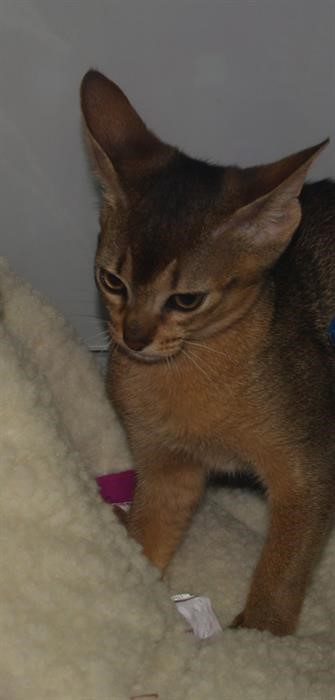 The Abyssinian is well-developed, muscly medium-sized cat. The male usually weighs an average of 6 to 9 pounds (2.7 to 4.1 kg). The female weighs 4 to 7 pounds (1.8 to 3.2 kg). It also has almond-shaped eyes, which are usually gold or green in colour.
The Abyssinian is well-developed, muscly medium-sized cat. The male usually weighs an average of 6 to 9 pounds (2.7 to 4.1 kg). The female weighs 4 to 7 pounds (1.8 to 3.2 kg). It also has almond-shaped eyes, which are usually gold or green in colour.
The Abyssinian belongs to the ticked or agouti breed, both terms used for the cat's type of fur. Its distinctive feature is its silky, multi-coloured coat, which is a combination of several colours on each hair shaft. Each strand of hair has dark coloured bands, contrasting with the light coloured bands, and ending with a dark tip.
Common Potential Health Problems
Abyssinians are usually healthy; however, some individuals may be prone to various health issues.
- Gingivitis and tooth decay.
- Early-onset periodontal disease.
- Hyperesthesia syndrome – excessive physical sensitivity, for example the skin, or may be sensitive to stimulus of the senses.
- Patellar luxation which results in movement of the kneecap.
- Progressive retinal atrophy resulting in degeneration of the retina causing loss of sight.
- Pyruvate kinase deficiency (PKD). Pyruvate kinase is an enzyme which is required by red blood cells, this deficiency results in the breaking down of red blood cells causing haemolytic anaemia.
- Renal amyloidosis.
PKD tests are now available, and it is strongly recommended that any Abyssinian, or Somali cats (another breed prone to PKD) that are used for breeding should be tested.
Personality and Temperament
Of all the cat breeds, the Abyssinian is perhaps the liveliest and the one who lives life to the fullest. They are highly inquisitive and nothing escapes the notice of this highly intelligent cat. They are energetic, entertaining and there is never a dull moment if you own an Abyssinian. This cat does not overly enjoy being handled, but it can amuse itself.
It is a bundle of energy and enjoys toys whilst also enjoys a climb climbing. You can easily teach this cat to do tricks and play training games making it a good breed for children. These cats enjoy company of either humans or another cat, preferably another Abyssinian.
Care
The short, fine coat of the Abyssinian is easily cared for with combing to remove dead hair and distribute skin oils. A bath when the cat is shedding will help to remove excess hair more quickly.
Brush the teeth to prevent periodontal disease. It is also important to ensure the eyes and ears are kept clean, and nails trimmed when required.
History and Background
Some believe that the Abyssinian originated from Egypt as they compare the breed to Egyptian murals, paintings and sculptures and find they prove a likeness. We do know that Romans transported cats from Egypt to Europe. Other people believe that the Abyssinian may have originated from the African Wildcat, although more modern research shows that the breed may have derived from Southeast Asia and India’s coastline.
It is believed in 1868, when the Abyssinian war ended, Lieutenant General Sir Robert Napier and his troop brought Zula, and Abyssinian cat, back to England. Zula was first documented in 1876 by Dr William Gordon Stables who wrote about Zula in his book.
The Abyssinian was most certainly developed in the United Kingdom, and later became exhibited in Boston, Massachusetts, USA in the 1909. It was not until the 1930’s that the breed became more popular and began success in shows. In 1938, a red coated Abyssinian was brought from Britain to the USA and grasped the attention of cat fanatics. It was from then on enthusiasts would import Abyssinians from the UK to the USA, increasing the popularity of the breed in today’s world.
This is an extract from our Cat Care ebook; scheduled publication date May 2016. After this date it can be purchased as a download on this web site.